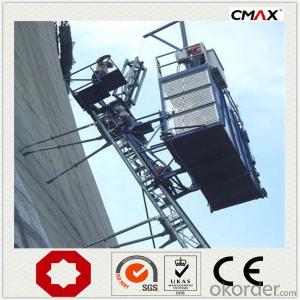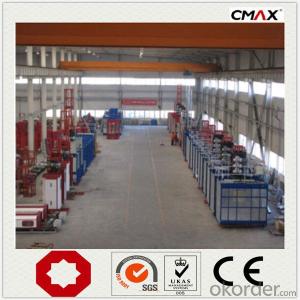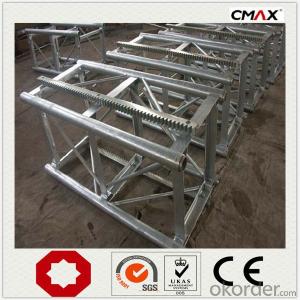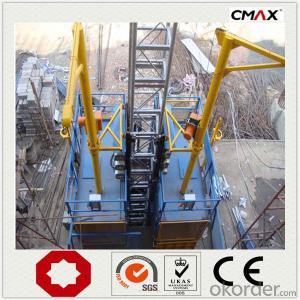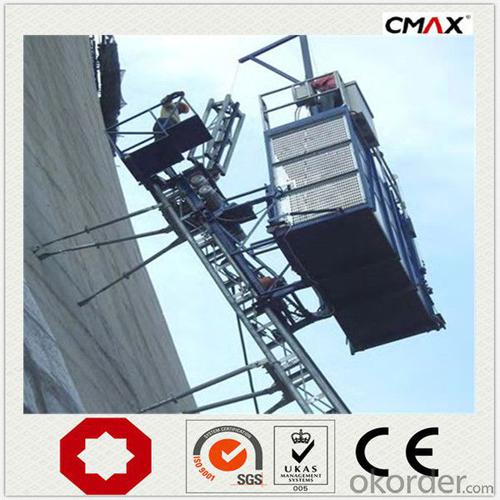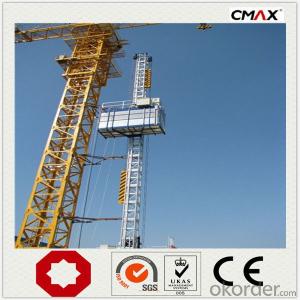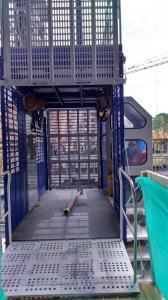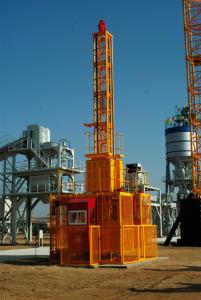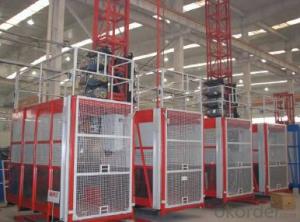Building Hoist Construction Handing Equipment
- Loading Port:
- China main port
- Payment Terms:
- TT OR LC
- Min Order Qty:
- 1 unit
- Supply Capability:
- 100 unit/month
OKorder Service Pledge
OKorder Financial Service
You Might Also Like
Structure of Building Hoist Description
The general building hoist manufactured by our company have the features as good quality, long life, wide application range and convenient for maintenance. The gearing adopted bearing,enameled cable, and oil seal. The electric parts adopt products from worl renowned manufacturers such as Schneider, Siemes, and LG. The racks and pinion adopts specal material and heat-treatment technique, which prolong the life of these parts. The steel structure uses quality steel from famous domestic manufacturers. The surface of the structure can apply paint-spray, parkerizing baking finish or hot galvanizing processing according to users requirments. The cage can be produced and decorated by aluminum molded board, punched-plate or figured aluminum board.
Main Features of Building Hoist
1. The recomended cage dimension(L*W*H)(m): 2.0*1.0*2.5, 2.5*1.0*2.5, 2.5*1.3*2.5, 3.0*1.5*2,5, 3.2*1.5*2.5, 3.8*1.5*2.5, 4.0*1.5*2.5, 4.2*1.5*2.5 etc. We can also manufacture cages of other size according to the user.
2. The cage and the door material can be aluminum molded board, punched-plate, figured aluminum board or other type according to yout requirements.
3. The mast section and the tie-in surface can adopt paint-spray, or hot galvanizing processing..
Building Hoist Specifiction
SC series product also has special design, such as reinforced guide rail with cross-section of 800mm, inclined type, special for cooling tower, etc. All the double cage building hoist can be changed into single cage type,
| Type | Payload(kg) | Lifting Speed (m/min) | Motor Power(kw) | Safety Device | ||
| Single Cage Hoist | No Counterweight | SC100 | 1000 | 33 | 2*11 | SAJ30-1.2 |
| SC120 | 1200 | 33 | 2*11 | SAJ30-1.2 | ||
| SC160 | 1600 | 33 | 2*11 | SAJ30-1.2 | ||
| SC200 | 2000 | 33 | 3*11 | SAJ40-1.2 | ||
| SC250 | 2500 | 33 | 3*11 | SAJ50-1.2 | ||
| SC270 | 2700 | 33 | 3*15 | SAJ50-1.2 | ||
| SC300 | 3000 | 33 | 3*15 | SAJ50-1.2 | ||
| SC320 | 3200 | 33 | 3*15 | SAJ50-1.2 | ||
| With Counterweight | SCD200 | 2000 | 33 | 2*11 | SAJ40-1.2 | |
| SCD250 | 2500 | 33 | 2*11 | SAJ50-1.2 | ||
| SCD270 | 2700 | 33 | 2*15 | SAJ50-1.2 | ||
| SCD300 | 3000 | 33 | 2*15 | SAJ50-1.2 | ||
| SCD320 | 3200 | 33 | 2*15 | SAJ50-1.2 |
Images of Building Hoist
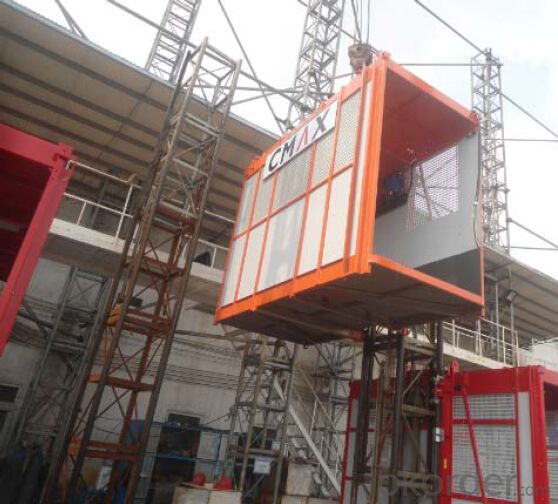
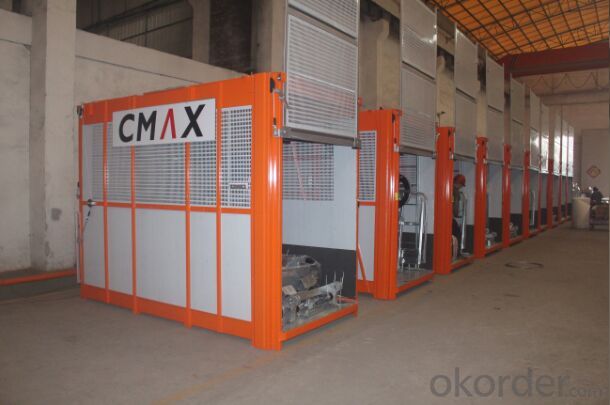
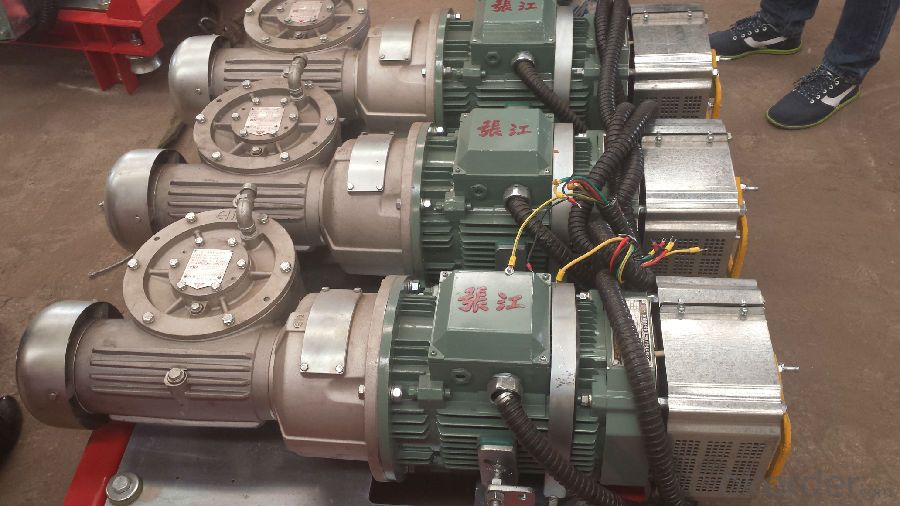
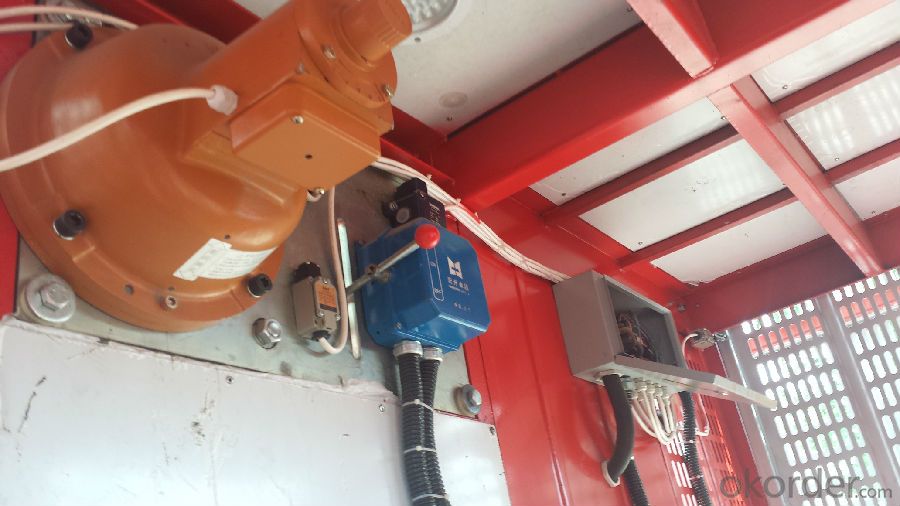

FAQ of Building Hoist
Q: What is the building hoist main purpose?
A: Building hoist equipped with double or single cabin to transport the materials and labors up and down. It's the ideal
construction equipment for vertical transportation in the field of construction.
Q: What is the main structure of building hoist?
A: The P/M construction hoist mainly contains metal structure, driving system, electrical control system, cable guide & protection system, electrical top crane and safety device.
Q: What is the meaning of the building hoist’s code?
A: Take SC200/200 for example: “SC” stands for rack and pinion hoist, “200/200” stands for double cage and capacity is 2 tons per cage. “SC200” stands for single cage and capacity is 2 tons.
- Q: This question asks for the proper usage guidelines for a building hoist, a mechanical device used in construction to lift materials.
- <p>To use a building hoist correctly, follow these steps: Ensure the hoist is inspected and certified for safe operation. Check all safety devices, including limit switches and emergency stops, are functioning. Securely attach the load to the hoist's hook, ensuring it's balanced and within weight limits. Never exceed the hoist's capacity. Operate the hoist with caution, avoiding sudden starts or stops. Keep the hoist area clear of people and obstacles. Use a tag line to guide the load if necessary. Always lower the hoist when not in use and secure it against wind or other forces. Regular maintenance and inspections are crucial to prevent accidents.</p>
- Q: This question asks about the typical issues encountered with lifting devices and seeks advice on how to prevent these problems.
- <p>Common problems with lifting devices include mechanical failure, overloading, improper use, and lack of maintenance. To avoid these issues, ensure regular inspections and maintenance, follow the manufacturer's guidelines for weight limits, and train operators on proper use. Additionally, implement safety protocols, such as load testing and visual inspections before each use, and consider using lifting devices with safety features like overload protection and limit switches.</p>
- Q: This question asks for a description of the process of using an emergency stop button specifically in the context of a building hoist.
- <p>To use an emergency stop button on a building hoist, first, ensure you are familiar with the hoist's controls and safety features. Locate the emergency stop button, which is typically a red mushroom-shaped button or switch, prominently placed and easily accessible. In an emergency, press and hold the button firmly. This action will immediately stop all hoist functions, including movement and operation. After pressing the emergency stop, evacuate the area if necessary and notify the appropriate personnel to address the situation. Remember, the emergency stop should only be used in situations where immediate action is required to prevent harm or damage. Regular training and drills can help ensure you are prepared to use the emergency stop button correctly and effectively.</p>
- Q: Is it possible for a building hoist to simultaneously lift and lower various materials?
- <p>Yes, a building hoist can be used to raise and lower different materials at the same time, provided it has the necessary capacity and the materials are properly secured. This is often done by using multiple hooks or platforms, each designated for different materials. It's crucial to ensure that the combined weight does not exceed the hoist's load limit and that safety protocols are strictly followed to prevent accidents.</p>
- Q: Is it advisable to use personal lifting equipment without seeking professional advice first?
- <p>No, it is not advisable to use your own lifting equipment without consulting professionals first. Lifting operations can be hazardous and require specific knowledge and expertise to ensure safety. Professionals can assess the weight, stability, and appropriate lifting techniques required for your equipment. They can also provide guidance on safety regulations and the correct use of lifting gear, which is crucial to prevent accidents and injuries. Always consult with experts before undertaking any lifting tasks to ensure compliance with safety standards and to protect yourself and others.</p>
- Q: This question asks about frequent issues related to building hoists and seeks solutions for these problems.
- <p>Common problems with building hoists include mechanical failures, electrical issues, overloading, and safety malfunctions. Mechanical failures can be fixed by regular maintenance, lubrication, and replacement of worn parts. Electrical problems may require checking wiring, connections, and replacing faulty components. Overloading can be prevented by strictly adhering to the hoist's weight limit and using load indicators. Safety malfunctions, such as brake failure, require immediate attention and may involve replacing brake pads or overhauling the braking system. Always ensure that hoists are used according to the manufacturer's guidelines and are regularly inspected by qualified personnel to prevent accidents and ensure safe operation.</p>
- Q: Is it possible to utilize a manual building hoist for the purpose of lifting heavy objects?
- <p>Yes, a manual building hoist can be used for lifting heavy objects. These hoists are designed to handle significant weights and are commonly used in construction for moving materials and equipment to various heights. They are operated manually, often with a hand crank or lever, and are equipped with safety features to prevent accidents. However, it's crucial to ensure that the hoist is rated for the weight of the objects being lifted and that all safety protocols are followed to avoid any accidents.</p>
- Q: This question asks about the precautions and safety protocols that should be followed when using lifting equipment in construction projects.
- <p>Safety measures for using lifting equipment in construction work include regular inspections and maintenance of the equipment, ensuring all safety features are in place and functioning correctly. Operators must be trained and certified for the specific type of lifting equipment they are using. Load limits should never be exceeded, and all loads must be secured properly. Safe operating procedures should be followed, such as not lifting loads over people and maintaining a safe distance from power lines. Personal protective equipment (PPE) must be worn by operators and workers in the vicinity. Emergency procedures should be established and communicated to all workers. Regular safety briefings and training sessions should be conducted to keep safety at the forefront of all operations.</p>
- Q: Explain the distinctions between electric and electric-motorized building hoists.
- <p>Electric building hoists are powered by electricity and typically use a motor to lift and lower loads. They are designed for vertical transport of materials in construction settings. Electric-motorized hoists, on the other hand, are a specific type of electric hoist that emphasizes the use of an electric motor for operation. The primary difference lies in the level of automation and control. Electric-motorized hoists often have more advanced features like variable speed control and may be integrated into larger systems for automated material handling. Both are efficient, but electric-motorized hoists offer higher precision and control, making them suitable for more complex applications.</p>
- Q: Is it possible to replace a motor in a building hoist with a hydraulic cylinder?
- <p>While a hydraulic cylinder can provide linear motion and force, it is not a direct substitute for a motor in a building hoist. Hydraulic cylinders are used for lifting and pushing applications, but they lack the variable speed and control that a motor provides. Motors, especially electric ones, offer precise control, variable speed, and efficiency which are critical for hoisting operations. A hydraulic system would require additional components like pumps and valves for control, making it more complex and less energy-efficient compared to an electric motor system. Therefore, a hydraulic cylinder alone is not suitable as a direct replacement for a motor in a building hoist.</p>
Send your message to us
Building Hoist Construction Handing Equipment
- Loading Port:
- China main port
- Payment Terms:
- TT OR LC
- Min Order Qty:
- 1 unit
- Supply Capability:
- 100 unit/month
OKorder Service Pledge
OKorder Financial Service
Similar products
Hot products
Hot Searches
Related keywords
